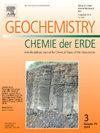Formation of pseudotachylytes under granulite facies conditions in the UHT In Ouzzal terrane (Western Hoggar, Algeria): Witnesses of paleoseism in the Paleoproterozoic lower continental crust at 0.82 Ga
IF 2.9
3区 地球科学
Q2 GEOCHEMISTRY & GEOPHYSICS
引用次数: 0
Abstract
Archaean charnockitic orthogneisses transected by 2.0 Ga high-grade exhumed ductile shear zones form part of the ultra-high temperature In Ouzzal Terrane, located in the western Hoggar, within the Neoproterozoic Pan-African Trans-Saharan belt of north-west Africa. Faults and injection veins of pseudotachylytes exhibit sharp contacts with their host charnockitic orthogneisses and are composed of a dark, and sometimes banded matrix, containing numerous clasts of pyroxene, feldspar, quartz, and rarely biotite. Recrystallized mineral assemblages in the matrix are indicative of granulitic facies conditions and consist of very fine-grained crystals of hypersthene, phlogopite, oligoclase, orthoclase, quartz, and accessory Mn-ilmenite and Cr-magnetite. This assemblage differs from that of the charnockitic orthogneiss host notably by the absence of the mesoperthitic K-feldspar. The chemical compositions of the pseudotachylytes are in general similar to those of the charnockitic orthogneisses suggesting a non-selective melting process consistent with in situ and total recrystallization. The chemical variations are observed in Tin Tchik Tchik pseudotachylytes and shear planes, including slight enrichments of calcium in orthopyroxene, plagioclase, and K-feldspar, as well as iron in biotite. These variations are attributed to recrystallization under decreasing temperature during faster cooling. The newly formed granulitic-facies mineral phases within the pseudotachylytes are synchronous with brittle deformation, lining fractures parallel to major shear zones and occupying spaces created by T-fractures, or those between Riedel R and T fractures, or P and R'. This Riedel fracture network indicates NW-SE to WNW-ESE shortening.
The 40Ar/39Ar dating of the pseudotachylyte matrix indicates its formation at 820.5 ± 6.6 Ma, providing the first evidence of early Neoproterozoic tectonism in the In Ouzzal terrane. Regionally, this event corresponds to the convergence period between the West African Craton and East Saharan Craton leading to subduction and the development of oceanic/continental arcs in western Hoggar. Earlier polyphase dehydration of charnockitic orthogneiss, during Archaean partial melting events (2.65 and 2.5 Ga) and Eburnean (2.0 Ga) ultra-high temperature metamorphism, suggests a reactivation under brittle coseismic conditions of Paleoproterozoic ductile main shear zones at 0.82 Ga in a nearly anhydrous lower crust and provides a natural example of earthquakes in the lower continental crust, controlled by a brittle rheology.
Ouzzal地块(阿尔及利亚Hoggar西部)UHT麻粒岩相条件下伪岩的形成:0.82 Ga古元古代下大陆地壳古地震活动的见证
太古宙炭质正长岩被2.0 Ga高质量的韧性剪切带所横切,形成了位于Hoggar西部的超高温In Ouzzal地体的一部分,位于非洲西北部新元古代泛非跨撒哈拉带内。假长石的断层和注入脉与它们的寄主炭质正长石有着尖锐的接触,由暗色的、有时呈带状的基质组成,含有大量辉石、长石、石英的碎屑,很少有黑云母。基质中的重结晶矿物组合指示了粒状相条件,由细粒超长石、绢云母、少长石、正长石、石英以及附属的锰钛矿和铬磁铁矿组成。该组合不同于炭质正长石,主要是缺少中厚长石钾长石。伪水晶石的化学成分一般与炭质正长岩相似,表明其熔融过程与原位和全重结晶一致。在Tin - Tchik - Tchik型假长石和剪切面中观察到化学变化,包括在正辉石、斜长石和钾长石中轻度富集钙,以及在黑云母中轻度富集铁。这些变化归因于在快速冷却过程中温度降低时的再结晶。伪岩浆岩内新形成的粒状相矿物相与脆性变形同步,衬缝平行于主剪切带,占据T型裂缝或Riedel R和T型裂缝之间或P和R′裂缝形成的空间。Riedel裂缝网络显示NW-SE - WNW-ESE缩短。通过40Ar/39Ar定年,表明其形成于820.5±6.6 Ma,为乌扎尔地体新元古代早期构造活动提供了第一个证据。从区域上看,这一事件对应于西非克拉通与东撒哈拉克拉通的辐合期,导致了俯冲和海陆弧的发育。在太古宙(2.65和2.5 Ga)部分熔融事件和Eburnean (2.0 Ga)超高温变质期间,较早的炭质正长岩多相脱水表明,在0.82 Ga的近无水下地壳中,古元古代韧性主剪切带在脆性同震条件下的再活化,为下大陆地壳中受脆性流变控制的地震提供了一个自然的例子。
本文章由计算机程序翻译,如有差异,请以英文原文为准。
求助全文
约1分钟内获得全文
求助全文
来源期刊

Chemie Der Erde-Geochemistry
地学-地球化学与地球物理
CiteScore
7.10
自引率
0.00%
发文量
40
审稿时长
3.0 months
期刊介绍:
GEOCHEMISTRY was founded as Chemie der Erde 1914 in Jena, and, hence, is one of the oldest journals for geochemistry-related topics.
GEOCHEMISTRY (formerly Chemie der Erde / Geochemistry) publishes original research papers, short communications, reviews of selected topics, and high-class invited review articles addressed at broad geosciences audience. Publications dealing with interdisciplinary questions are particularly welcome. Young scientists are especially encouraged to submit their work. Contributions will be published exclusively in English. The journal, through very personalized consultation and its worldwide distribution, offers entry into the world of international scientific communication, and promotes interdisciplinary discussion on chemical problems in a broad spectrum of geosciences.
The following topics are covered by the expertise of the members of the editorial board (see below):
-cosmochemistry, meteoritics-
igneous, metamorphic, and sedimentary petrology-
volcanology-
low & high temperature geochemistry-
experimental - theoretical - field related studies-
mineralogy - crystallography-
environmental geosciences-
archaeometry
 求助内容:
求助内容: 应助结果提醒方式:
应助结果提醒方式:


